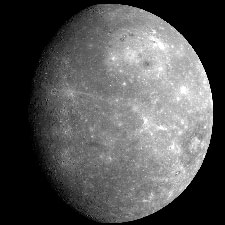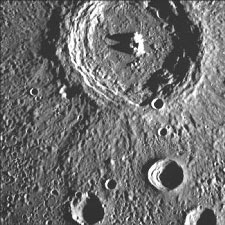Mercury
The planet Mercury is the closest planet to the Sun in our solar system and is roughly the size of the Earth’s Moon - this makes Mercury the smallest planet in our solar system.
Although small, the planet has a high density which scientists believe is due to large deposits of iron within the core of the planet.
It is estimated that the core of the planet makes up approximately 42% of the overall planet volume.
This is in comparison with a core volume of the Earth of around 17%.
Due to the fact that Mercury is so close to the Sun, it only takes 88 days to orbit the Sun, much shorter than the 365 days it takes the Earth to orbit fully around the Sun!
Mercury through the ages
If you know where to look in the night sky and choose the right times of the year for your location, you can sometimes see Mercury. Ancient astronomers will no doubt have seen Mercury over the ages and the first recorded observation of the planet was in 14th Century BC by an Assyrian astronomer that noted its existence in the Mui Apin tablets.
The Ancient Greeks gave Mercury the name Apollo when it was first viewed in the morning and Hermes when it was viewed at night. It was only many years later at around the 4th Century BC that they realised they were observing the same planet so simply called it Hermes. The Romans later named the planet after the Roman messenger god, Mercury, and the planet has been known by this name ever since.
Have we visited Mercury?
Mercury is far too inhospitable for humans to visit – at day it can be too hot and at night too cold! But we have sent probes to view Mercury from space. The first spacecraft that was sent to visit Mercury was the NASA Mariner 10 which launched in the 1970’s. It was the first craft to provide close up images of the surface of Mercury and incredibly the craft flew at its closest a mere 327 kilometres from the surface of the planet.
The second spacecraft that was sent to Mercury was the NASA MESSENGER spacecraft. It made three fly-bys of the planet starting in 2008 and managed to map the remainder of the surface of the planet that could not be mapped by the previous Mariner 10 craft. This helped us to understand further the geology and temperature extremes of the planet.
Facts about Mercury
Mercury is the closest planet in our solar system to the Sun. Even so, it is still between 46 to 70 million kilometres away (depending on where the planet lies during its orbit of the Sun).
Scientists believe that Mercury was formed approximately 4.6 billion years ago.
We can sometimes see Mercury shining brightly in the morning sky which has given the planet the nickname “The Morning Star”.
Even though we are sometimes able to view Mercury with the naked eye, it is still believed to be the smallest planet in our solar system. It is similar in size to our own Moon and about two fifths the size of the planet Earth.
Mercury is subject to amazing differences in surface temperature depending on which side of the planet is facing the Sun. The side that faces the Sun (during daytime) can reach high temperatures of over 400 degrees Celsius, whilst the other side which is not facing the Sun (Night time) can have temperatures as low as -173 degrees Celsius.
You would expect Mercury to be the hottest planet in our solar system because it is closest to the Sun, but this is not the case. Venus is the hottest planet, with Mercury in second place.
There is no real atmosphere on Mercury. The low level of gravity (around a third the level of gravity on the Earth) means that there is not enough gravity to keep hold of an atmosphere so it is continually lost to the solar winds.
As there is a lack of atmosphere, the planet often gets hit by comets and asteroids so the surface of Mercury has many craters and looks a little like the surface of the Moon.
The planet takes 88 days to orbit the Sun (orbit means the time the planet takes to travel in space completely around the Sun). This means a year on Mercury lasts for just under 116 earth days.
Mercury does not have a single Moon.
Figures and Statistics
| Mercury | Earth | Ratio (Planet to Earth) | |
| Rotation period - (hours) | 1407.6 | 23.9345 | 58.785 |
| Length of day - (hours) | 4222.6 | 24.00 | 175.94 |
| Length of year (earth days) | 115.88 | 365 | 0.317 |
| One complete orbit takes (earth days) | 87.969 | 365.256 | 0.241 |
| Radius (km) | 2439.7 | 6378.1 | 0.383 |
| Mass (1024 kg) | 0.3301 | 5.9726 | 0.0553 |
| Volume (1010 km3) | 6.083 | 108.321 | 0.0562 |
| Density (kg/m3) | 5427 | 5514 | 0.984 |
| Distance from Earth - Min (106km) | 77.3 | - | - |
| Distance from Earth - Max - (106km) | 221.9 | - | - |
| Average distance from Sun (106km) | 57.91 | 149.6 | 0.387 |
| Orbital radius (106km) | 46-70 | 147-152 | 0.31 - 0.46 |
| Orbital velocity (average - km/s) | 47.36 | 29.78 | 1.590 |
| Rotational velocity (km/h) | 10.892 | 1674.4 | 0.0066 |
| Surface gravity (m/s2) | 3.70 | 9.81 | 0.378 |
| Surface temp - Min (K) | 100 | 184 | 0.5434 |
| Surface temp - Max (K) | 700 | 330 | 2.1212 |
| Axial tilt (degrees) | 0.034 | 23.44 | 0.001 |
| Number of natural satellites (moons) | 0 | 1 | - |
-
Notes on the above figures:
- Orbits are invariably elliptical in nature. The average distance from the sun that appears above is also known as a 'semi-major axis', which is the mean (average) radius of the elliptical orbit.
- Axial tilt is also known as 'obliquity to orbit' and is the angle of rotation of the body itself with an imaginary line drawn through both poles, relative to its plane of orbit.
- Radius figures quoted are equatorial measurements. As most bodies exhibit 'oblateness' - that is to say that they appear slightly squashed - the radius from the centre to the poles would invariably be shorter.
- The Kelvin temperature scale is used for all temperature measurements above. 0K is equivalent to -273.15°C (degrees Celsius). To convert from K to C, simply subtract this figure from the Kelvin temperature given.
- Use of 'Index Notation' for very large numbers as above can be explained as follows; 106 = 10 x 10 x 10 x 10 x 10 x 10, or 1,000,000. For example, if you see a number that appears as 6x1011 then that number written in full would be 6 x 10 x 10 x 10 x 10 x 10 x 10 x 10 x 10 x 10 x 10 x 10 - or 600,000,000,000. Index notation allows us to write very big (or very small) numbers down far more concisely.


